Tumbleweed
A tumbleweed is a structural part of the above-ground anatomy of a number of species of plants, a diaspore that, once it is mature and dry, detaches from its root or stem, and rolls due to the force of the wind. In most such species, the tumbleweed is in effect the entire plant apart from the root system, but in other plants, a hollow fruit or inflorescence might detach instead.[1] Xerophyte tumbleweed species occur most commonly in steppe and arid ecosystems, where frequent wind and the open environment permit rolling without prohibitive obstruction.[2]
Apart from its primary vascular system and roots, the tissues of the tumbleweed structure are dead; their death is functional because it is necessary for the structure to degrade gradually and fall apart so that its seeds or spores can escape during the tumbling, or germinate after the tumbleweed has come to rest in a wet location. In the latter case, many species of tumbleweed open mechanically, releasing their seeds as they swell when they absorb water.[3]
The tumbleweed diaspore disperses seeds, but the tumbleweed strategy is not limited to the seed plants; some species of spore-bearing cryptogams—such as Selaginella—form tumbleweeds, and some fungi that resemble puffballs dry out, break free of their attachments and are similarly tumbled by the wind, dispersing spores as they go.[4][5]
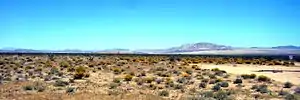
Plants that form tumbleweeds
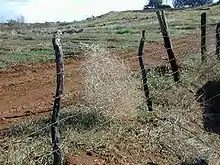
The tumbleweed dispersal strategies are unusual among plants; most species disperse their seeds by other mechanisms. Many tumbleweeds are ruderal species, opportunistic agricultural weeds. Tumbleweeds have been recorded in the following plant groups:[6]
- Amaranthaceae (including Chenopodiaceae)
- Amaryllidaceae
- Asphodelaceae
- Asteraceae
- Brassicaceae
- Boraginaceae
- Caryophyllaceae
- Fabaceae
- Lamiaceae
- Poaceae
In the family Amaranthaceae s.l. (i.e. broadly defined to include Chenopodiaceae), several annual species of the genus Kali are tumbleweeds. They are thought to be native to Eurasia, but when their seeds entered North America in shipments of agricultural seeds, they became naturalized in large areas. In the cinema genre of Westerns, they have long been symbols of frontier areas. Kali tragus is the so-called "Russian thistle". It is an annual plant that breaks off at the stem base when it dies, and forms a tumbleweed, dispersing its seeds as the wind rolls it along.[7] It is said to have arrived in the United States in shipments of flax seeds to South Dakota, perhaps about 1870.[8] It now is a noxious weed throughout North America, dominating disturbed habitats such as roadsides, cultivated fields, eroded slopes, and arid regions with sparse vegetation. Though it is a troublesome weed, Kali tragus also provides useful livestock forage on arid rangelands.[9]
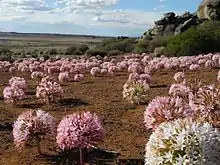
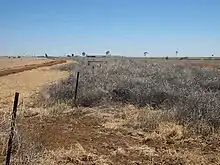
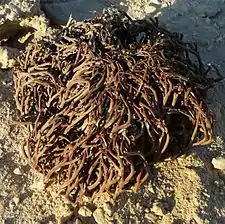

Other members of the Amaranthaceae (s.l.) that form tumbleweeds include Kochia species,[10][11] Cycloloma atriplicifolium, and Corispermum hyssopifolium,[10] which are called plains tumbleweed.[12] Atriplex rosea is called the tumbling oracle or tumbling orach.[13][14]
Among the Amaranthaceae (s.s.) that form tumbleweeds, there are several species of Amaranthus, such as Amaranthus albus, native to Central America but invasive in Europe, Asia, and Australia; and Amaranthus graecizans, native to Africa, but naturalized in North America.[15] Amaranthus retroflexus, which is indigenous to tropical North and South America, has become nearly cosmopolitan largely as a weed, but like many other species of Amaranthus, it also is widely valued as animal forage and as human food, though it should be utilised with caution to avoid toxicity.[16]
Several Southern African genera in the family Amaryllidaceae produce highly optimised tumbleweeds; their inflorescences are globular umbels with long, spoke-like pedicels, either effectively at ground level, or breaking off once the stems are dry. When the seeds are about ripe, the fruit remain attached to the peduncles, but the stem of the umbel detaches, permitting the globes to roll about in the wind. The light, open, globular structures form very effective tumbleweed diaspores, dropping their seeds usually within a few days as the follicles fail under the wear of rolling. The seeds are fleshy, short-lived, and germinate rapidly where they land. Being poisonous and distasteful, they are not attractive to candidate transport animals, so the rolling diaspore is a very effective dispersal strategy for such plants. Genera with this means of seed dispersal include Ammocharis, Boophone, Crossyne and Brunsvigia.[17]
Some species of the Apiaceae form tumbleweeds from their flower umbels, much as some Amaryllidaceae do.[1]
In the Asteraceae, the knapweed Centaurea diffusa forms tumbleweeds. It is native to Eurasia and is naturalized in much of North America. Also in the Asteraceae, Lessingia glandulifera, native to America, sometimes forms tumbleweeds; it grows on sandy soils in desert areas, chaparral, and open pine forests of the western United States.[18]
In the Brassicaceae, Sisymbrium altissimum, Crambe maritima, Lepidium, and a resurrection plant, Anastatica form tumbleweeds.
In the Caryophyllaceae, the garden plant "baby's-breath" (Gypsophila paniculata), produces a dry inflorescence that forms tumbleweeds. In parts of central and western North America, it has become a common weed in many locations including hayfields and pastures.[19]
In the legume family (Fabaceae), Baptisia tinctoria and some species of Psoralea produce tumbleweeds. In Psoralea the tumbleweed detaches from the plant by abscission of the stem.[20]
In the Plantaginaceae, Plantago cretica forms tumbleweeds.
Inflorescences that act as tumbling diaspores occur in some grasses, including Schedonnardus paniculatus and some species of Eragrostis and Aristida.[21] In these plants, the inflorescences break off and tumble in the wind instead of the whole plant, much as happens in some of the Apiaceae and Amaryllidaceae. The species of Spinifex from Southeast Asia are prominent examples of this dispersal adaptation.[22] These grasses are often called tumble-grasses, including such species as Panicum capillare and Eragrostis pectinacea in the United States.[23]
In the Solanaceae, Solanum rostratum .[10] forms tumbleweeds.
Wind dispersed fruits that tumble or roll on the ground, sometimes known as "tumble fruits", are rare. Some are technically achenes. Highly inflated indehiscent fruits that may facilitate tumbling include Alyssopsis,[24] Coluteocarpus,[24] Physoptychis,[24] Sutherlandia and Physaria.[24]
Very similar in habit to Anastatica, but practically unrelated, are the spore-bearing Selaginella lepidophylla (a lycopod) and earthstar mushroom family (Geastraceae). All of these curl into a ball when dry and uncurl when moistened.
Bovista, a genus of puffball, uses essentially the same dispersal strategy.
Environmental effects
_Blocking_Home_California.png.webp)
The United States Department of Agriculture classified the ubiquitous tumbleweeds as a non-native and extremely invasive plant in the United States. They are considered noxious in nature and detrimental in many ways. Tumbleweeds thrive with disturbed soil situations and are a major contributor to native plant extinctions and wildfires, being highly flammable and bouncing over or rapidly growing in land cleared of vegetation between fields or areas of forest as firebreaks. Despite over a century of cooperation between Mexican, Canadian, and U.S. governments to combat the species, tumbleweeds can be found in most regions of North America.[25][26]
Some ruderal species that disperse as tumbleweeds are serious weeds that significantly promote wind erosion in open regions. Their effects are particularly harmful to dry-land agricultural operations where the outside application of additional moisture is not practicable. One study showed that a single Russian thistle can remove up to 167 liters (44 gallons) of water from the soil in competition with a wheat crop in one year.[27] The amount of water removed from fallow land more subject to erosion would be even more damaging.
It sometimes happens that species of large tumbleweed, especially if thorny, can form aggregations that are physically hazardous and can block roads and cover buildings and vehicles. This can most obviously happen where fences and similar obstacles cause the accumulation, but the weeds can also entangle each other spontaneously until they form piles that can no longer roll. Such piles can be a serious threat to trapped vehicles or buildings and their occupants, most particularly because they are dry and flammable. Examples of enveloped buildings and vehicles have been documented mainly in the Western regions of the US. In residential areas, an example was the town of Mobridge, South Dakota, where tens of tons of large tumbleweeds ("Russian thistles") that had matured in the dry bed of nearby Lake Oahe buried many houses so deeply that mechanical equipment was necessary to remove it, release occupants, and counter the fire hazard.[28][29]
There was a significant outbreak of Panicum effusum in the Australian town of Wangaratta in February 2016 that attracted international attention. The seed heads of the weed, known locally as "hairy panic", had piled several meters deep in some places, forcing residents to spend several hours removing it to regain access to their doors and homes.[30][31][32] The local council subsequently indicated it was considering attaching large vacuums to street-sweepers in an attempt to control the outbreak.[33]
On April 18, 2018, strong winds and neglected maintenance of neighboring private land brought in a very large number of tumbleweeds into Victorville, California and about 100 to 150 homes required help from public services after their entryways were at least partly blocked off. The local fire department also participated in the cleanup as the massive influx of tumbleweeds presented both a safety and fire hazard.[34]
A similar incident occurred on December 31, 2019, when high winds dislodged a large number of tumbleweeds on the Hanford Reservation northwest of Richland, Washington. The tumbleweeds piled up 15 to 20 feet (5–7 meters) deep in some areas, burying cars and trucks and closing Washington State Route 240 for ten hours while road crews used snowplows to remove the tumbleweeds.[35][36]
Tumbleweeds have also been observed to cause issues with wastewater treatment plants. In some cases of inadequate fencing, they can get entangled in electromechanical equipment within plants such as clarifiers and mechanical aerators leading to increased energy use and labor cost associated with operating and cleaning the units.[37]
References
- William Francis Ganong (1921). A Textbook of Botany for Colleges. MacMillan Co. p. 359.
- Dirk V. Baker (2007). Dispersal of an Invasive Tumbleweed. pp. 90–. ISBN 978-0-549-44310-0.
- W. F. Ganong (1896). "An outline of phytobiology". Bulletin of the Natural History Society of New Brunswick. 13: 3–26, page 1 errata. page 16
- Orson K. Miller, Jr.; Hope H. Miller (1988). Gasteromycetes: Morphological and Developmental Features with Keys to the Orders, Families, and Genera. Mad River PressInc. ISBN 978-0-916422-74-5.
- Bulletin. Ohio State University. 1928.
- Baker, Dirk V. (2007). Dispersal of an Invasive Tumbleweed. p. 3. ISBN 978-0-549-44310-0.
- Main, Douglas. "Consider the tumbleweed". scienceline.org. Retrieved 4 August 2011.
- Epple, Anne (1997). Plants of Arizona. Falcon. p. 352. ISBN 978-1-56044-563-0.
- Salsola tragus Linnaeus in Vol. 4 Page 399, 400, 401, 402 Flora of North America, eFloras.org.
- Louis Hermann Pammel (1903). Some Weeds of Iowa. Experiment Station, Iowa State College of Agriculture and the Mechanic Arts. page 477
- D. A. Becker (1978). "Stem abscission in tumbleweeds of the Chenopodiaceae: Kochia". American Journal of Botany. 65 (4): 375–383. doi:10.2307/2442692. JSTOR 2442692.
- Chenopodiaceae, Standardized nomenclature, Texas A&M University: Center for the Study of Digital Libraries.
- WILDLAND FIRE MANAGEMENT PLAN: SACRAMENTO NATIONAL WILDLIFE REFUGE COMPLEX, U.S. Fish and Wildlife Service.
- Atriplex rosea Linnaeus, in Vol. 4 Page 326, 340, 358 Flora of North America, eFloras.org.
- Matt Jolley Abrams, LeRoy (1944). Illustrated Flora of the Pacific States Volume 2. Stanford University Press. p. 644. ISBN 978-0-8047-0004-7.
- Watt, John Mitchell; Breyer-Brandwijk, Maria Gerdina: The Medicinal and Poisonous Plants of Southern and Eastern Africa 2nd ed Pub. E & S Livingstone 1962
- Manning, John (2008). Field Guide to Fynbos. Cape Town: Struik Publishers. ISBN 9781770072657.
- Lessingia glandulifera in Vol. 20 Page 452, 454, 456 Flora of North America, eFloras.org.
- Gypsophila paniculata Linnaeus in Vol. 5 Flora of North America, eFloras.org.
- D. A. Becker (1968). "Stem abscission in the tumbleweed, Psoralea". American Journal of Botany. 55 (7): 753–756. doi:10.2307/2440962. JSTOR 2440962.
- Gibson, David J. (2009). Grasses and grassland ecology. Oxford: Oxford University Press. p. 52. ISBN 978-0-19-852919-4.
- Dawson, John; Lucas, Rob (2005). The nature of plants : habitats, challenges, and adaptations. Melbourne. p. 314. ISBN 0-643-09161-0.
- Pound, Roscoe; Clements, Frederic E. (1977). The phytogeography of Nebraska. New York: Arno Press: Arno Press. p. 156. ISBN 0-405-10417-0.
- O. Appel and I. A. Al-Shehbaz (12 September 2002). "Cruciferae". In K. Kubitzki and C. Bayer (ed.). The families and genera of vascular plants. 5: Flowering Plants: Dicotyledons: Malvales, Capparales and Non-betalain Caryophyllales. Springer. pp. 75–174. ISBN 3-540-42873-9. page 83
- https://plants.usda.gov/plantguide/pdf/pg_satr12.pdf
- http://file.lacounty.gov/SDSInter/acwm/215984_WADTProgram.pdf
- Parker, Ph.D., Robert (2003). DROUGHT ADVISORY EM4856 – Water Conservation, Weed Control Go Hand in Hand (PDF). Washington State University Cooperative Extension.
- Marilyn Stablein (1995). Climate of Extremes: Landscape and Imagination. Black Heron Press. pp. 33–. ISBN 978-0-930773-39-7.
- "Toledo Blade - Google News Archive Search". google.com.
- "Australia town consumed by 'hairy panic'". BBC News. British Broadcasting Corporation. 18 February 2016. Retrieved 12 May 2016.
- "Video: 'Hairy Panic' tumbleweed takes over Australian homes". Belfast Telegraph. 18 February 2016. Retrieved 12 May 2016.
- Halkon, Ruth (18 February 2016). "Entire town buried under bizarre 'hairy panic' weed that has baffled experts". Mirror (UK). Retrieved 12 May 2016.
- "Big vacuums could combat 'hairy panic' in Australia city". BBC News. British Broadcasting Corporation. 19 February 2016. Retrieved 12 May 2016.
- 'Houses Disappeared' When Tumbleweeds Rolled Into This California City
- The Meteorology of the Tumbleweed Storm. Plus, The Ukrainian Connection : Cliff Mass Weather And Climate Blog on Blogger, retrieved 2020-01-03
- @wspd3pio (1 January 2020). "Tumblegeddon" (Tweet) – via Twitter.
- Thompson, M. (2018) 'Evaluating Opportunities and Barriers to Improving the Energy Efficiency of Small Nebraska Wastewater Treatment Plants',pp.83
External links
| Look up tumbleweed in Wiktionary, the free dictionary. |
| Wikimedia Commons has media related to Tumbleweed. |
- Video showing a massive displacement of tumbleweed in the Mojave desert.
- Howard, Brian Clark (17 December 2015). "Watch a Plague of Tumbleweeds Blow Across the West". National Geographic.
.jpg.webp)